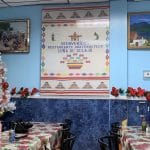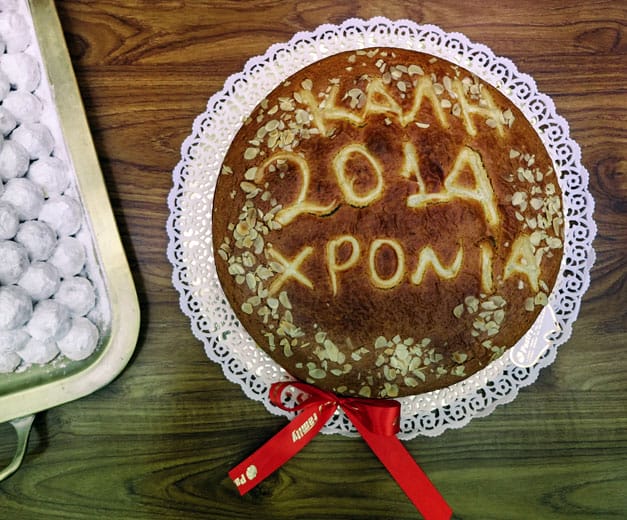Just after the stroke of midnight on New Year’s Eve or on the first day of the New Year, many Greek Orthodox families gather around the table to cut and split the vasilopita, a cake named after St. Basil (Aghios Vasilios), the Greek Santa Claus. The head of the family “crucifies” the cake three times with a knife and then cuts it into triangular pieces. Usually, the first piece is offered to Christ, the second to the Virgin Mary, the third to St. Basil and the fourth to the “house” before family members and friends each receive one. Some may offer a slice to St. Nicholas, the patron of sailors, to the poor, as St. Basil cared for them, or to the family shop or company. The custom of dividing the vasilopita is performed at many events throughout January and even into early February among many associations, agencies and other organizations. Each person wishes the others chronia polla (“many years”) and “Happy New Year” to bless the house and to bring good luck.
A vasilopita usually contains a fluri, or lucky coin, which is placed in the dough before baking. These days, the fluri is a common coin, but once upon a time it was a gold or silver piece. Whoever finds the coin in his or her slice is said to be particularly blessed and will supposedly be lucky for the next year (and thus keeps it for the duration). If the coin goes to Christ it means that the whole family will be protected, while if it goes to the house, it is a blessing for the entire household. Vasilopita has its roots in ancient Greco-Roman traditions, such as Saturnalia (the feast of the god Cronus, worshiped in Greece) and the Roman Saturnalia, where, in similar fashion, coins were tucked into sweets and pies for lucky recipients.
Legend also has it that when St. Basil was the bishop of Caesarea in Cappadocia, Asia Minor, the Eparch of Cappadocia came to plunder the town. St. Basil asked the villagers to collect their jewelry and coins to provide a ransom to the conqueror and to dissuade him from looting the area. However, the Eparch backed down either because he regretted the action or because Saint Mercurius and a host of angels miraculously dismissed his army. But when it came time to return the valuables, St. Basil, not knowing who owned what, instructed the villagers to prepare small loaves. He placed one of the coins or valuables into each and distributed the loaves to the whole town on the day of church worship.
 There are two kinds of traditional vasilopita: a fluffy, yeasted sweet brioche called politiki vasilopita (from Poli or Constantinople, now known as Istanbul) and a classic cake. Both are prepared mainly from flour, eggs, sugar and milk, but across Greece, variations abound, with loaves studded with nuts and dried fruit, savory versions that resemble cheese or leek pies in West Macedonia or even modern recipes with chocolate. They may be left plain, dusted with sugar or sesame or decorated with the year written with rows of almonds or with white icing.
There are two kinds of traditional vasilopita: a fluffy, yeasted sweet brioche called politiki vasilopita (from Poli or Constantinople, now known as Istanbul) and a classic cake. Both are prepared mainly from flour, eggs, sugar and milk, but across Greece, variations abound, with loaves studded with nuts and dried fruit, savory versions that resemble cheese or leek pies in West Macedonia or even modern recipes with chocolate. They may be left plain, dusted with sugar or sesame or decorated with the year written with rows of almonds or with white icing.
Our favorite politiki vasilopita can be found at Toula in Pagrati. When we step into the tiny shop, the alluring scents of fresh goat butter and the spices mahlepi (made from the seeds of a kind of cherry) and mastic (made from the resin of the lentisk tree) take our breath away. We also love the vasilopita at Takis bakery in Koukaki; the loaf has a wonderfully well-developed flavor and is perfect with a glass of milk before bedtime. Further north, Divan of Palaio Faliro in Phaleron makes an authentic politiki sprinkled with sesame seeds. If we find ourselves on the other side of Athens, we head to Varsos in Kifisia. The wait is long but worth it.
For the cake version, Pastry Family has for 45 years prepared the same superb recipe, redolent with the fragrance of orange and almonds and remarkably moist and rich. When we’re downtown, we seek out the vanilla- and orange-scented version at Aristokratikon, the old Athenian chocolate shop near Syntagma. Whichever version we choose, we always check to make sure it contains a lucky coin. Kali Chronia! Happy New Year!
 February 1, 2019 Luna de Xelajú
February 1, 2019 Luna de Xelajú
Along Parsons Boulevard one cold night in January, a crowd of people in heavy winter […] Posted in Queens June 12, 2019 Neighborhood Rivalries
June 12, 2019 Neighborhood Rivalries
Over the course of June, Lisbon’s neighborhoods are perfumed with the smoke of barbecued […] Posted in Lisbon May 6, 2016 Queens
May 6, 2016 Queens
In 1654, Dutch refugees, including 23 Jews, traveling on a French ship from Brazil, […] Posted in Queens Migrant Kitchens, Queens
Published on January 01, 2014
Related stories
February 1, 2019
QueensAlong Parsons Boulevard one cold night in January, a crowd of people in heavy winter coats line up for the buses that will take them to Rosedale, Hollis, and Pomonok. But behind a small storefront just steps away, Luna de Xelajú offers a transporting experience of a different kind, to somewhere much warmer. The restaurant’s…
June 12, 2019
LisbonOver the course of June, Lisbon’s neighborhoods are perfumed with the smoke of barbecued sardines. It’s one of the most prominent features of the traditional arraiais, the festivals that pop in each neighborhood at this time of year, offering grilled fish and pork, beer and sangria, and music. While all this eating, drinking and making…
May 6, 2016
QueensIn 1654, Dutch refugees, including 23 Jews, traveling on a French ship from Brazil, arrived in North America. The refugees set foot in Peter Stuyvesant’s New Amsterdam village, now called New York. Stuyvesant did not want to accept Jews, so he imposed trade, property and tax restrictions to stifle their advancement. Most of the Jewish…

















































































